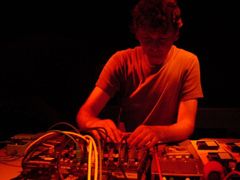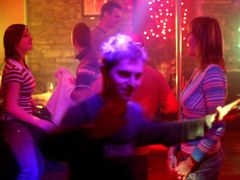Prague - Joy, a New York University student studying in Prague, watches as a small man in his 20s flails his limbs awkwardly to the electrifying drum'n'bass beat. His shirt, once white, is now completely drenched and made transparent by sweat, catching the neon lights at the Prague nightclub Roxy.
"I better be tripping like that boy over there soon!" she claps and shouts over the pulsating music.
In about half an hour, Joy is yanking her head from side to side, her hair sticking to her sweat-dotted face. She makes frequent breaks throughout the night to grab Cokes from the bar, gnawing the straw as she boogies back to the dance floor.
Before the night began, Joy, who asked to have her name changed to protect her privacy, popped an ecstasy pill. She had bought the drug, also known as "x" or "XTC", from a Czech dealer for CZK 200, or $11.61. An hour after ingesting it, she was at the center of the sweaty mass on the dance floor, pumping up her fists at the DJ.
Such drug-riddled dance fests are anything but rare in the Czech Republic. The Central European country's love for synthetic club drugs has made them the leading users of ecstasy in the European Union, surpassing countries with much wilder nightlife scenes like Spain and the United Kingdom.
According to the European Monitoring Centre for Drugs and Drug Addiction, 7.7 percent of Czechs between the ages of 15-34 experimented with ecstasy in 2007, the latest statistics available. That is higher than the United States rate of 2.5 percent and more than four times the EU average.
For Joy, all it took was a casual stroll around Roxy to locate potential suppliers.
Within ten minutes, she had purchased a small pink pill from one of the many dealers stationed there, offering late-night revelers whatever they need to keep the party going.
"I know I probably was ripped off because I didn't know the dealer all that well, but as long as it's good, I don't care," adds Joy. "It's still cheaper than what I probably would have paid for back home in the States."
A tablet can be bought for as little as EUR2.8, or $4.10, making the Czech Republic one of the least expensive EU countries to buy ecstasy. And it's easy to buy, too.
"Anything you want, I can get it," promises George, 29, over the loud, throbbing blend of hip-hop and techno at Radost FX, one of Prague's most popular dance spots.
Hailing from the small West African nation of Guinea, George works as an electric technician by day but is always there to "help a friend out" with a pill or a puff at night.
"I have been here for three years, so I know everybody, I can get anything for you." Ecstasy? "Oh yeah, no problem. Just wait here," replies George, sauntering off in search of a fellow dealer.
A synthetic substance with a chemical make-up similar to amphetamines, ecstasy, which is more commonly referred to as "speed", is a favorite among clubbers for its ability to induce feelings of euphoria, intensify sensory experience, and fuel hours of non-stop dancing.
"Ecstasy is a typical club drug," says Dr. Viktor Mravcik, head of the Czech National Monitoring Centre for Drugs and Drug Addiction.
Mravcik points to the 1990s as the decade that changed it all. "It was the peak of dance music, and ecstasy is the drug of parties and discos."
The decade marked a pivotal moment in the history of the Czech Republic - the transition from communism to a market economy. After the Velvet Revolution, the country rapidly embarked on the path to capitalism, opening the country up to everything from McDonalds to the drug trade.
Paul Griffiths, an expert at the European Monitoring Centre, told the Czech newspaper Mlada Fronta Dnes that drug use among young people began to climb after the country opened its borders.
"Young people very quickly got acquainted with the West's drug addiction," he said.
Ecstasy flooded into the post-Communist markets far later than it did the West's, and while Western tastes have moved on, interest in the drug here remains high. A report by the Slovenian government stated that in 1998, seven to 13 percent of 15-year olds there have tried the drug at least once, making it the second most common drug after marijuana.
Jakub Frydrych, the director of the Czech National Drug Headquarters police force, told The Prague Post in February that the Czech Republic is becoming a "target destination for drugs" because of the improving economic situation.
The Czechs, at $25,395 a year, enjoy the second-highest average annual salary in the post-communist region, just a few steps behind Slovenia. Ukraine, on the other hand, has been on an economic rollercoaster, which the World Health Organization links to its fluctuating rates of ecstasy consumption. During rough times, users in Ukraine opt for the locally produced ephedrine, a cheaper drug that is similar to ecstasy.
Ecstasy is aggressively advertised as a dangerous and potentially fatal drug in the United States. However, the Czech Republic views the occasional drug use as citizens embracing their "right to dope in their leisure time," says Frydrych, a view that does little to reduce ecstasy's presence in the country.
According to the United Nations World Drug Report, the percentage of 15 and 16-year old Czechs who have experimented with ecstasy swelled from 0.2 percent in 1995 to 8.3 percent in 2003.
People often turn to ecstasy to "try to intensify the enjoyment of the event and to raise self-confidence," says Frydrych. He adds that ecstasy is perceived as less dangerous because it is usually swallowed in pill form, does not have the "social stigma of 'dirty' drugs like heroin," and is generally used only as a weekend party drug.
Mark Titman, a therapist at the Drop-in Centre, a clinic in Prague that offers care to drug users and drug-prevention programs, believes that the relaxed attitude towards drugs contributes to the continued popularity of ecstasy. "Czech society is quite liberal about using ecstasy during musical and dance events," says Titman.
George, the dealer from Guinea, agrees. "The Czech Republic is a good country for drugs," he says, flashing a smile. "Yes, there are some police, but people are relaxed - just be careful, and you can do whatever."
A 2006 European Commission study of 15- to 30-year old regular clubbers found that 27 percent have tried ecstasy at least once. Carried out in nine European cities, including the second-largest city in the Czech Republic, Brno, the study also revealed that habitual use of the drug was low, lying at 1.4 percent.
"A lot of young people experiment with ecstasy, but without subsequent problem," says Titman. "We have a lot of 'try it once or twice' users, so I don't think ecstasy use is a big problem here."
Titman says long-term ecstasy consumption is rare, as frequent users often graduate to pervitin, a drug which is dangerously addictive and can cause long-term psychological damage.
The World Health Organization notes that Czech youth often see ecstasy as a rather harmless drug, since it is used infrequently and most medical treatment administered treats temporary adverse effects rather than addiction. It recommends that a bigger emphasis be placed on preventive education programs that dispel this myth, as the organization lists hyperthermia, depression, anxiety, long-term memory impairment, and liver damage as potential effects of even sporadic use.
The information does little to scare Joy, who says, "Look, I'm here to have fun. I'll do it once in a while, when I'm out clubbing with friends. What's the big deal?"
This story was originally published by the Prague Wanderer, a web-zine run by New York University students in Prague, Czech Republic.
Linda Witters is a third-year student at New York University studying politics and journalism. She is from Shanghai, China.









